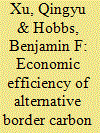|
|
|
Sort Order |
|
|
|
Items / Page
|
|
|
|
|
|
|
| Srl | Item |
| 1 |
ID:
171376


|
|
|
|
|
| Summary/Abstract |
Policy makers across Europe have implemented renewable support policies with several policy objectives in mind. Among these are achieving ambitious renewable energy targets at the lowest cost, reducing CO2-emissions and promoting technology improvement through learning-by-doing. Using a detailed country-level model of generation markets, we address the question of how policies that subsidize renewable energy (feed-in premia and renewable portfolio standards (RPSs)) versus capacity (investment subsidies) impact the mix of renewable investments, electricity costs, renewable share, the amount of subsidies, and consumer prices in the EU electric power market in 2030 and how they interact with other policies such as the EU ETS. Our analysis shows that subsidies of energy output are cost-effective for achieving renewable energy targets in the short run, whereas policies tied to capacity installation yield more investment and might be more effective in reducing technology costs in the longer term. The difference in costs between these two policy options diminish with higher CO2-prices. Although the differences are significant, they are smaller than cost impacts of other renewable policy design features, namely the effect of not allowing EU members to meet their individual targets by trading renewable credits with other member states.
|
|
|
|
|
|
|
|
|
|
|
|
|
|
|
|
| 2 |
ID:
179729


|
|
|
|
|
| Summary/Abstract |
To be effective, policies addressing power sector carbon emissions in jurisdictions that are embedded in larger carbon markets must account for carbon embodied in imports and the potential for leakage. Yet analyses of alternative border carbon adjustment (BCA) policies that carefully model the impact of generation mix, net load distributions, and transmission limits are rare in the literature. With a generation-transmission expansion planning model of Western North America, we compare the impacts of alternative BCA schemes that California's carbon pricing system could implement. These include no BCA, facility (import source)-based deemed emission rate, a facility-neutral and constant (over-time) rate, and a facility-neutral and dynamic rate. Our results suggest that, when compared to no BCA or BCA using facility-based deemed rates, a facility-neutral BCA can improve efficiency by simultaneously lowering market-wide emissions and costs without raising California consumer expenditures. Emissions leakage also declines significantly. The precise value of the deemed rate affects these gains; setting it equal to marginal emission rates external to California is most efficient. We also show that California's carbon pricing encourages more interstate transmission expansion because power imports become more profitable. However, BCAs that cost-effectively lower total regional emissions will dampen those incentives.
|
|
|
|
|
|
|
|
|
|
|
|
|
|
|
|
| 3 |
ID:
105794


|
|
|
|
|
| Publication |
2011.
|
| Summary/Abstract |
We briefly consider the tensions between climate change and energy security policy imperatives, and highlight some concepts that may bring additional clarity to decision-making at the nexus of the two areas. We focus on developing countries and use the case of the Medupi supercritical coal plant in South Africa. The justification for the plant's construction stemmed from an Integrated Resource Planning process informed by South Africa's national utility. Often, as in the case of South Africa, there are tensions not easily captured in quantitative algorithms between, inter alia, a lack of access to electricity by millions of people (and associated welfare losses) and greenhouse gas emissions from electricity generation. It is difficult to identify any formal processes that have prioritised climate change considerations over those of energy access. Thus, it becomes imperative to have a clear understanding of the consequences of this reality when considering power system expansion. We find that the processes often employed do not provide an entirely satisfactory precedent for future planning analyses, and the justifications do not adequately reflect the complexity of the decision space. Finally, we highlight some options by which these tools might be enhanced in areas including explicit and formal consideration of risk.
|
|
|
|
|
|
|
|
|
|
|
|
|
|
|
|
| 4 |
ID:
099278


|
|
|
|
|
| Publication |
2010.
|
| Summary/Abstract |
What are the economic consequences of increased state spending on electricity consumption efficiency? The State of Maryland faces this question in deciding how much of its CO2 allowances auction proceeds (under the Regional Greenhouse Gas Initiative) to devote to such programs. Starting at a base of 25% of the proceeds, we consider the energy savings, emissions reductions, employment, and other impacts of increasing that percentage to 50% and 100%. A series of models - Haiku, JHU-OUTEC, and IMPLAN - are used for the analysis. We conclude that increasing the state's expenditures on energy efficiency programs would result in a decline in electricity consumption in the state and a corresponding decline in expenditures on electricity. Program implementation would lead to net positive growth in statewide economic activity and include growth in both jobs and wages.
|
|
|
|
|
|
|
|
|
|
|
|
|
|
|
|
| 5 |
ID:
097529


|
|
|
|
|
| Publication |
2010.
|
| Summary/Abstract |
In electricity, "downstream" CO2 regulation requires retail suppliers to buy energy from a mix of sources so that their weighted emissions satisfy a standard. It has been argued that such "load-based" regulation would solve emissions leakage, cost consumers less, and provide more incentive for energy efficiency than traditional source-based cap-and-trade programs. Because pure load-based trading complicates spot power markets, variants (GEAC and CO2RC) that separate emissions attributes from energy have been proposed. When all generators and consumers come under such a system, these load-based programs are equivalent to source-based trading in which emissions allowances are allocated by various rules, and have no necessary cost advantage. The GEAC and CO2RC systems are equivalent to giving allowances free to generators, and requiring consumers either to subsidize generation or buy back excess allowances, respectively. As avoided energy costs under source-based and pure load-based trading are equal, the latter provides no additional incentive for energy efficiency. The speculative benefits of load-based systems are unjustified in light of their additional administrative complexity and cost, the threat that they pose to the competitiveness and efficiency of electricity spot markets, and the complications that would arise when transition to a federal cap-and-trade system occurs.
|
|
|
|
|
|
|
|
|
|
|
|
|
|
|
|
|
|
|
|
|